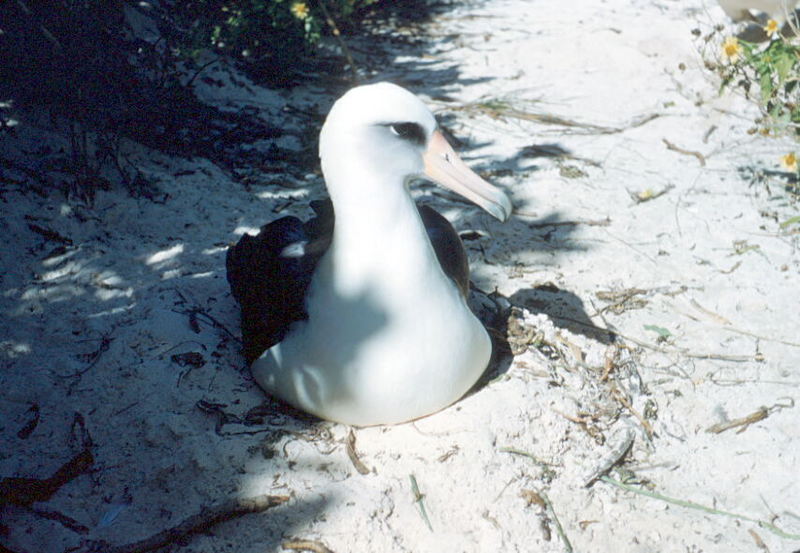ERROR : Server Busy(-1105)
ERROR : Server Busy(-1105)
Laysan Albatross (Phoebastria immutabilis) - Wiki
Laysan Albatross
From Wikipedia, the free encyclopedia
Order: Procellariiformes
Family: Diomedeidae
[Photo] Laysan Albatross Phoebastria immutabilis on nest by U.S. Fish and Wildlife Service (http://images.fws.gov). Date Issued: July 09 2001. License: public domain.
The Laysan Albatross, Phoebastria immutabilis, is a large seabird that ranges across the North Pacific. This small (for its family) albatross is the second most common seabird in the Hawaiian Islands, with an estimated population of 2.5 million birds, and is currently expanding (or possibly re-expanding) its range to new islands. It is named for Laysan, one of its breeding colonies in the Northwestern Hawaiian Islands.
Description
The Laysan Albatross is usually easy to identify, in the North Pacific it is simple to separate from the other relatively common albatross, the all black Black-footed Albatross. It can be distinguished from the very rare Short-tailed Albatross by its all dark back and smaller size. The Laysan Albatross' plumage has been compared to that of a gull, two tone with a dark grey mantle and wings, and white underside and head.
Behaviour and range
The Laysan Albatross has a wide range across the North Pacific. Its main breeding colonies are in the Hawaiian Islands, particularly the islands of Midway and Laysan. It also nests in the Bonin Islands near Japan, and has recently began to colonize islands off Mexico, such as Guadalupe Island. When away from the breeding areas they range widely from Japan to Alaska and down to California, but usually far offshore.
The Laysan Albatross is colonial, nesting on scattered small islands and atolls, often in huge numbers. They also have a protracted breeding cycle. Juvenile birds return to the colony three years after fledging, but will not mate for the first time until they are seven or eight years old. over these four or five years they form pair bonds with a mate that they will keep for life. Courtship entails especially elaborate 'dances' that have up to 25 ritualised movements.
Both birds incubate the single egg, with the male being the first to incubate the egg after laying. The incubation takes about 65 days, after which the chick is brooded for a few days, after which both parents are out at sea to provision for the growing chick. The chick takes about 160 days to fledge, a long investment for the parents (which may explain the long courtship, both parents want to sure the other is serious). The chicks are fed a stomach oil by the parents.
Conservation
The Laysan Albatross, while a common species, has not yet recovered from the wide-scale hunting that happened in the early 1900s, with feather hunters killing many hundreds of thousands, and wiping them out from Wake Island and Johnston Atoll. This slaughter led to efforts to protect the species (and others) which led eventually to the protection of the Northwestern Hawaiian Islands. The species is still vulnerable to long-line fisheries, and the injestion of floating plastics. On some of the new islands it has colonized it has also been taken by feral cats.
Lead poisoning is killing thousands of Laysan Albatross each year on Midway Atoll, part of the new Northwestern Hawaiian Islands Marine National Monument created by President George Bush this summer. The Laysan Albatross has been globally listed as Vulnerable to extinction by the World Conservation Union, and is a special trust species on the Midway National Wildlife Refuge in the newly established National Monument.
“Laysan chicks raised in nests close to 90 buildings left behind by the Navy are ingesting lead-based paint chips. This is causing shockingly high lead concentrations in their blood, leading to severe neurological disorders, and eventual death,” said George Fenwick, President of American Bird Conservancy. “Federal funds are urgently needed to cleanup this toxic mess to protect the Laysan Albatross as well as future visitors to the new Marine National Monument.”
Scientific studies have shown that Laysan Albatross chicks are eating lead-based paint chips peeling off of 95 aging buildings on the island; and that as many as 10,000 chicks, or five percent of hatched chicks, may be killed annually by exposure to lead-based paint. Many Laysan chicks that nest within five meters of building structures exhibit a condition referred to as "droopwing" which commonly manifests itself in the chicks’ inability to raise their wings, which drag on the ground resulting in broken bones and open sores. Chicks with droopwing will never be able to fly, and will die of starvation or dehydration. Other chicks within close proximity to buildings also suffer detrimental effects from lead exposure. These chicks have blood lead concentrations that cause immunological, neurological, and renal impairments, significantly decreasing their chances of survival.
The Department of Interior (DOI) estimates that $5.6 million is needed to cleanup the toxic lead paint on Midway Atoll. The 95 federally owned government buildings must be stripped of all lead-based paint, and sand areas surrounding these old buildings need to be thoroughly sifted to remove lead paint chips. When American Bird Conservancy staff presented the severity of this growing threat to an already-imperiled bird species to top Department of Interior officials, they were told that the new Northwestern Hawaiian Islands Marine National Monument did not have any federal funds or resources dedicated to its operation. Moreover, the DOI officials stated that the current federal budget for the nation’s wildlife refuge system would be insufficient to prevent the continued ingestion of lead paint by Laysan chicks.
http://en.wikipedia.org/wiki/Laysan_Albatross
| The text in this page is based on the copyrighted Wikipedia article shown in above URL. It is used under the GNU Free Documentation License. You may redistribute it, verbatim or modified, providing that you comply with the terms of the GFDL. |
|

